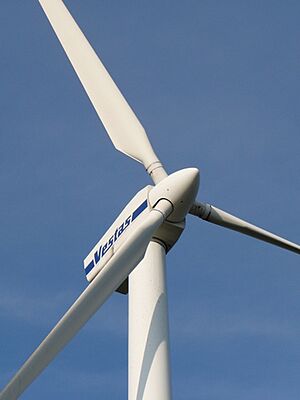Low voltage ride through facts for kids
Low voltage ride through (LVRT) is a special ability that some electrical devices have. It helps them keep working even when the electricity voltage drops suddenly. Think of voltage like the "push" of electricity. If the push isn't strong enough, many machines might stop working or get damaged.
LVRT makes sure that important equipment can handle these short drops in power. This is super important for keeping our lights on and our devices running smoothly.
Contents
What is Low Voltage Ride Through?
Electricity comes to our homes and schools with a certain amount of "push," which we call voltage. Sometimes, for a very short time, this voltage can drop. This is like when the water pressure in a hose suddenly gets weaker.
Without LVRT, many electrical devices would just shut down when the voltage drops. This could cause big problems, especially for things like power plants or important factory machines. LVRT allows these devices to "ride through" the low voltage period. They wait for the voltage to return to normal without completely turning off.
Why is LVRT Important?
Imagine a big power plant that makes electricity for thousands of homes. If the voltage drops for a moment, and the plant's equipment shuts down, it could cause a huge blackout. LVRT helps prevent this. It allows the equipment to stay connected to the power grid.
This is especially important for modern power systems. We rely on electricity for almost everything. LVRT helps keep our power supply stable and reliable. It protects expensive equipment from damage too.
How Does LVRT Work?
When the voltage drops, devices with LVRT don't just give up. Instead, they have special systems that can handle the dip. They might temporarily reduce their power output or switch to a different mode. This allows them to stay online and connected to the power grid.
Once the voltage goes back to normal, the device can quickly return to its full operation. This quick recovery is key. It prevents a small voltage dip from turning into a big power outage. It's like a car that can keep rolling even if it hits a small bump in the road.
LVRT in Renewable Energy
LVRT is very important for renewable energy sources like wind farms and solar power plants. These plants connect to the main electricity grid. If there's a voltage drop on the grid, these plants need to stay connected.
For example, a wind turbine (like the one in the picture) makes electricity. If the grid voltage drops, the turbine's system with LVRT will keep it running. It won't disconnect. This helps keep the power flowing from renewable sources. It also makes the entire power grid more stable.
Without LVRT, many wind turbines or solar panels might disconnect during a voltage dip. This would mean less clean energy going into the grid. It could also make the power system less reliable. So, LVRT helps us use more green energy safely.
LVRT in Your Daily Life
While you might not see LVRT directly, it affects your daily life. It helps keep the power grid stable. This means fewer blackouts and more reliable electricity for your home. It helps protect the devices that power your internet, your lights, and your entertainment.
Many modern electronic devices, even some in your home, have some form of voltage protection. This helps them last longer and work better. LVRT is a more advanced version of this protection, used in big industrial and power generation systems. It's a key part of keeping our modern world powered up.


